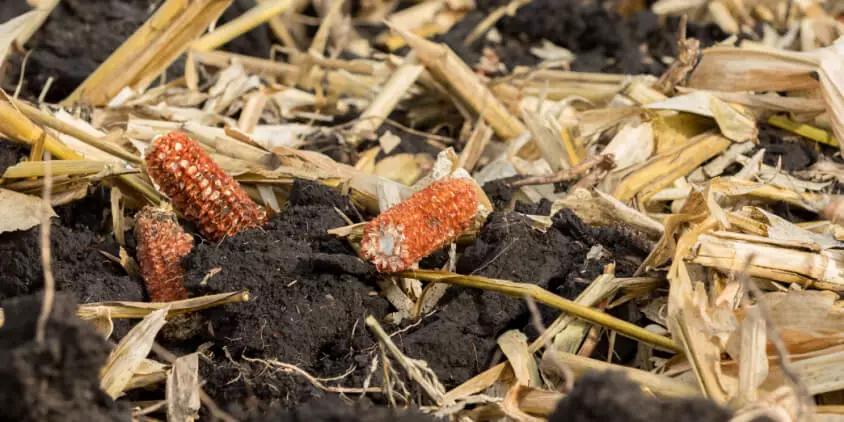
Crop Residue Management To Improve Soil Fertility
Amid expanding global populations and rising food demand, farmers need to improve agricultural productivity without compromising soil health. In light of this, sustainable crop residue management is becoming increasingly important.
Crop residue, the plant material left in the field after harvest, plays a crucial role in soil health, carbon sequestration, and erosion control. However, removing all the remnants doesn’t make for a good crop residue management example, nor does leaving too much, which can harbor pests and diseases. Our article will provide you with science-backed insights on optimizing crop residue management to enhance soil quality, farm productivity, and environmental stewardship.
What Is Crop Residue Management?
Crop residue management (CRM) is a strategy based on reducing the frequency and intensity of tillage operations and increasing the amount of leftover debris from previous harvests. The goal of this management approach is to conserve soil and water quality while providing numerous other ecological and economic benefits. High yields and reduced use of expensive inputs like fuel, electricity, and synthetic pesticides and fertilizers justify the switch to crop residue management in most situations.
Sowing high-residue plants or cover crops after low-residue plants is typically the initial step in CRM. The volume of remnants, their orientation (from standing stubble to lying prostrate), and their even distribution throughout the most demanding periods are other key aspects of this year-round management, spanning far beyond the post-harvest period.
Calculating Crop Residue Cover To Inform Management Decisions
Calculation can give a reasonable assessment of the remaining plant leftovers without in-site examination. However, keep in mind that it is merely a rough estimate and that lots of variables at play, including weather and equipment, could cause it to differ from what occurs in the field. Here’s an example of a calculation showing how much corn and soybean leftovers you might have after some common field operations .
| Activity | Corn leftovers, % | Soybean leftovers, % |
|---|---|---|
| Post-harvest | 90–95 | 80–90 |
| Cold-season decomposition | 80–90 | 70-80 |
| Plowing | 2–7 | 0–2 |
| Chiseling with a twisted shank | 40–50 | 10–20 |
| Deep offset disking | 25–40 | 10–20 |
| Paraplowing | 65–75 | 35–45 |
| Chiseling with a straight shank | 50–60 | 30–40 |
| Shallow tandem disking | 40–70 | 25–35 |
| Anhydrous application | 75–85 | 45–55 |
| Cultivation | 80–90 | 55–65 |
| Planting | 80–90 | 80–90 |
| Till-planting | 55–65 | 55–65 |
These figures can be used as a helpful reference in your crop residue management when determining the total residue percentage in the harvesting–planting time frame. Furthermore, based on this percentage, it is possible to deduce which technology the farmers followed.
To prevent soil erosion, aim for a residue cover of at least 30% after planting. According to the above calculations, a low-till approach gives easily 30–50% cover, while summer fallow, or combining over three primary tillage procedures, provides less than 30% cover.
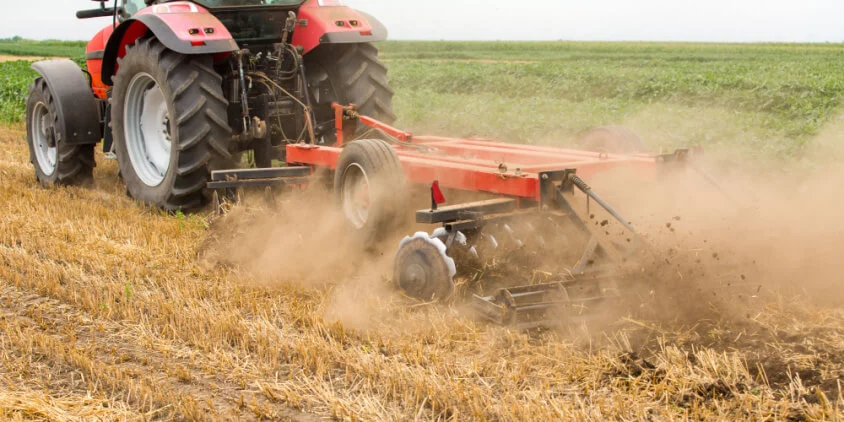
Benefits Of Proper Crop Residue Management
There’s undeniable importance of using appropriate crop residue conservation and management strategies because of the agronomic, economic, and environmental benefits they bring about. Locally adapted management approaches have the potential to improve soil quality, water retention, and crop yields, to name a few.
Improved Soil Health And Fertility
Well-planned crop residue management can improve soil fertility and overall soil health in the long run. Plenty of plant material left on the field after tillage contributes to an increase in yields by:
- mitigating or preventing soil erosion;
- keeping the soil at temperatures favorable for plant growth;
- promoting root growth;
- improving the soil pH and rendering more micronutrients available for plants;
- recycling nutrients for reuse;
- enriching the soil with organic matter, particularly carbon;
- supporting the microorganisms that live in the soil;
- improving the soil’s physical qualities, increasing the land’s ability to hold and drain water;
- reducing soil compaction;
- preserving land fertility.
Effective crop residue management is crucial for maintaining and, ideally, increasing soil productivity, which is especially important in fragile soils that are prone to degradation.
Water Conservation
More agricultural remnants left after harvest help the soil retain more water in the following ways:
- Reducing evaporation. Cover from plant leftovers allows less sunlight to penetrate the soil and slows the flow of air over the soil, both of which help to lower evaporation rates.
- Preventing soil erosion and surface runoff. Crop residue prevents soil detachment by soaking up the motion energy from falling raindrops. Thus, the soil surface crusts and seals less, allowing more water to soak and less to run off.
With the water-saving capabilities of crop residue and proper field management, growers can cut back on the amount of water used for irrigation.
Economic Benefits
The agricultural sector stands to earn greatly from sustainable crop residue management thanks to the opportunities for generating additional streams of income, boosting yield and profits, and offering new industrial uses . A few of the most noticeable gains from properly handling agricultural leftovers rather than wasting them include the following:
- Reduced input costs. Proper residue management minimizes the need for synthetic pesticides and fertilizers.
- Lower fuel and energy consumption. Using reduced tillage or no-till farming techniques, which often involve leaving agricultural leftovers on the field, can reduce the costs associated with soil preparation.
- Improved yields. Maintaining soil fertility through sustainable crop residue management allows for increased yields with fewer resources.
Environmental Benefits
Crop and soil type, climate, and cultivation methods all play a role in how beneficial crop residue management is for the environment. Here are the main advantages of using appropriate CRM strategies:
- Increase in organic matter content. Incorporating agricultural leftovers into the soil adds organic matter, which increases the soil’s capacity to hold water and nutrients and fosters vegetation growth.
- Biodiversity and habitat preservation. Plant remnants provide cover for beneficial insects and other organisms, helping maintain biodiversity and ecosystem health.
- Climate change mitigation. More plant material left in the field helps boost organic carbon and improve soil carbon sequestration. Farmers also lessen their carbon footprint since the frequency and intensity of field passes by agricultural machinery decrease.
Soil organic carbon and nitrogen pools are often diminished upon residue removal. The degree to which this occurs varies based on field-specific factors such as management duration, cultivation strategy, soil type, and climate.
To maximize the overall benefits, farmers should adopt a holistic approach to residue management that finds a sweet spot between economic and environmental factors.
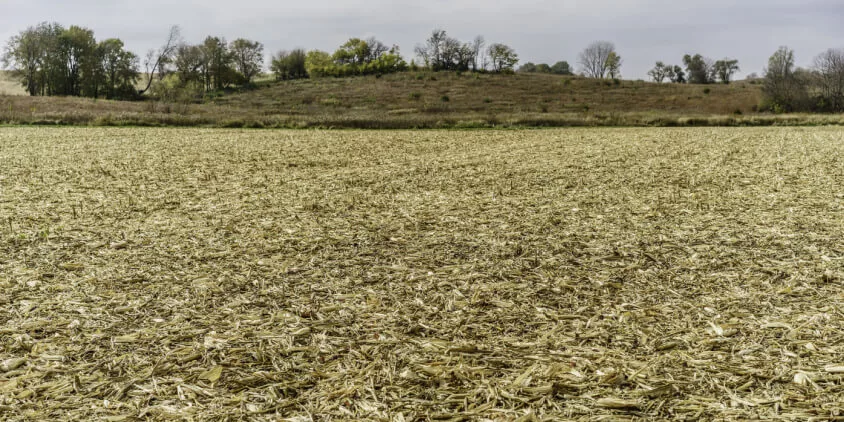
EOSDA Crop Monitoring
Fields monitoring platform, leveraging high-resolution satellite images to identify and react to any changes remotely!
Methods And Practices Of Crop Residue Management
Crop residue might be a valuable commodity because of its multiple applications in the feed, fiber, and bioenergy industries. Despite this, burning plant remains has been a common practice for many decades, even though it is a poor management option with numerous negative consequences. Low-till techniques combined with soil conservation measures are the most effective means of CRM. Let’s examine some of the current crop residue management practices more closely:
- No-till farming. In this management approach, residue is left on the field, and seeds are planted without first tilling the soil. Soil disturbance goes down as heavy machinery is kept from traversing the field too often. Furthermore, untouched plant leftovers enhance the soil by adding carbon, preventing erosion, and retaining soil moisture.
- Ridge-tillage. Farmers prepare elevated beds or ridges, between which plant remnants can accumulate. This improves water penetration and decreases soil erosion.
- Mulching. The idea behind this method of crop residue management is to leave remnants on the field, where they can serve as a barrier against environmental impacts. This proves helpful for preventing erosion, conserving water, and limiting weed growth. Mulching is highly beneficial for growing cotton as well as soybean and corn crops.
- Conservation practices. Cover cropping and rotating crops are essential for residue management because they provide the necessary field protection along with adding organic matter and nutrients, as in the case of legumes. In addition to preventing soil erosion and deterioration, these management practices can influence nutrient cycling in the field.
Tackling Crop Residue Management Challenges With EOSDA Crop Monitoring Solutions
The success of a particular CRM strategy depends on soil, climate, and plant traits, among other factors. So one potential disadvantage of crop residue management, according to some farmers, is that what works in one setting might fail in another. The optimal level of residues to be left in the field is also not easy to determine. Excessive cover can prevent soil-seed interaction, render nitrogen inaccessible for plant uptake, and keep the soil cold and damp. On the other hand, insufficient residue cover can degrade soil quality, contribute to organic matter loss, and increase erosion.
To reap the various benefits of crop residue management, farmers and agricultural specialists must share their expertise, do the necessary research, and make use of modern technology in the following areas.
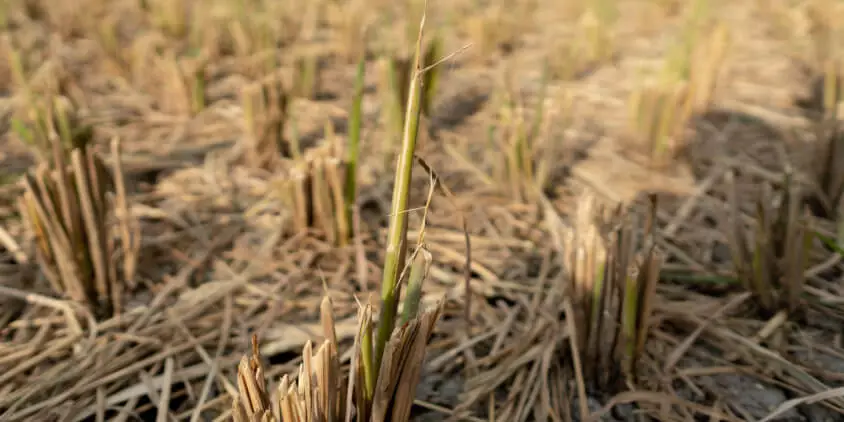
Volume-Dependent Variations In Crop Residue Management
After harvesting large swaths of land, there is a mountain of agricultural leftovers that must be dealt with. Plant parts that decay slowly, like stalks and roots, can accumulate on the field and hinder the following season’s soil preparation and planting. Cultivating plants in rotation adds complexity to crop residue management due to the differences in the amount, rate, and specific features of residue decomposition. For instance, straw cover left after growing rice often drives the loss of dissolved organic carbon, with further adverse effects on the soil and groundwater.
When faced with a large volume of leftovers, it may be tempting to use management tactics to minimize crop residue — let’s say, just burn them. However, burning causes the soil to lose organic matter and nutrients. In most cases, mulching and surface retention, which improve soil health in many ways, are preferable options for crop residue management, particularly in rice-wheat systems.
Large amounts of residue come with no easy management; neither do small amounts. When agricultural leftovers are insufficient, soil erosion and nutritional imbalances arise. With the help of a crop monitoring system, you can identify bare spots in your land that need more cover. This grasp will be particularly valuable for crop residue management within reduced tillage or no-till systems, where it is crucial to strike a balance between soil conservation and the capacity to use no-till planters.
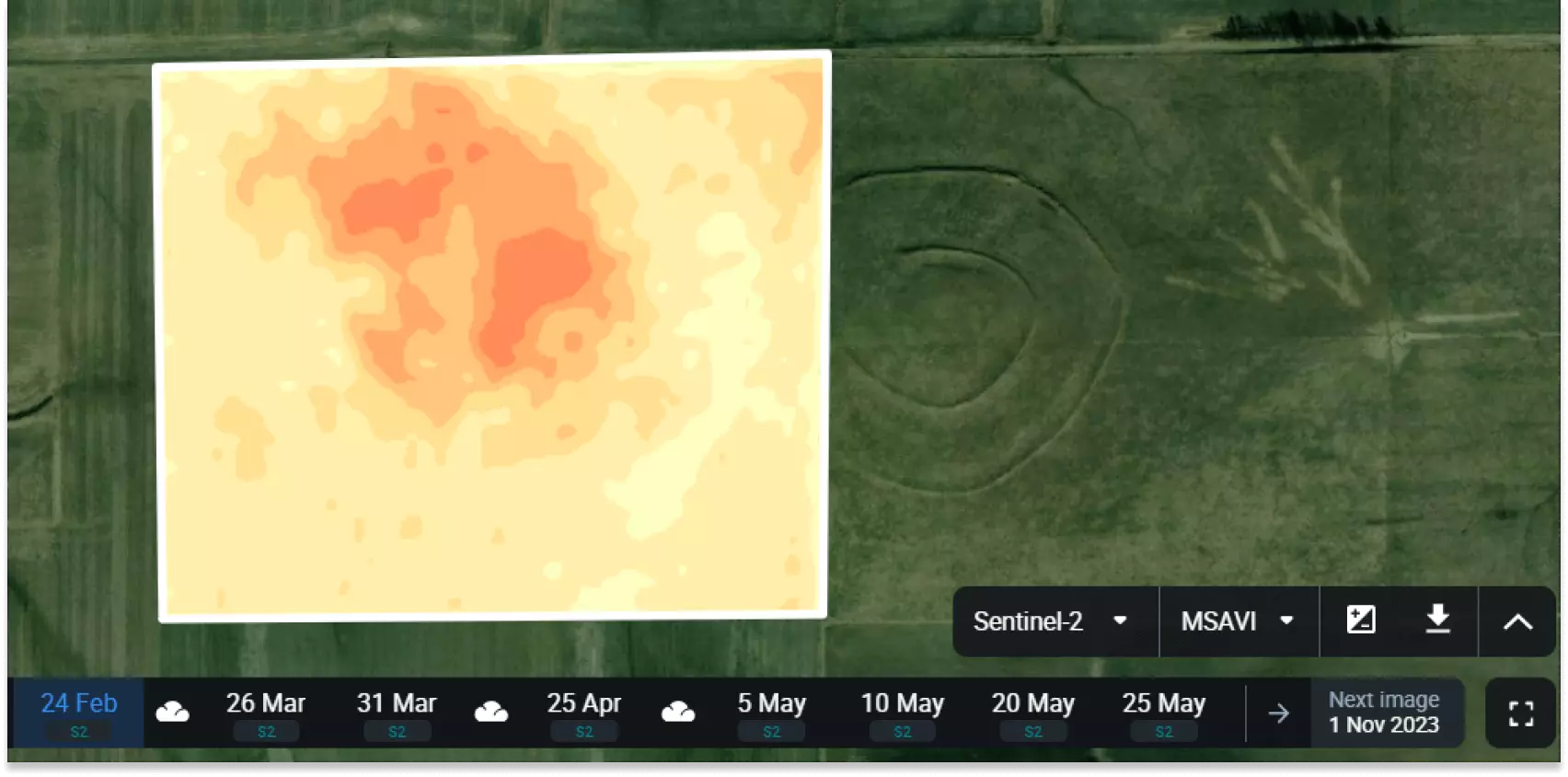
Pest, Disease, And Weed Management
Plant material remaining on the field may serve as a breeding ground for pests and disease carriers, as well as a supply of nutrients and a shelter for weed growth. While this may appear to be a crop residue management con, it actually means that control of pests, diseases, and weeds should go hand in hand with residue management.
Throughout the growing season, you can monitor the likelihood of disease appearing in your fields with the EOSDA Crop Monitoring’s Disease Risk tool and account for that information in your plans for crop residue management. Get daily risk status updates on crop disease threats based on plant growth stage and agricultural weather data.
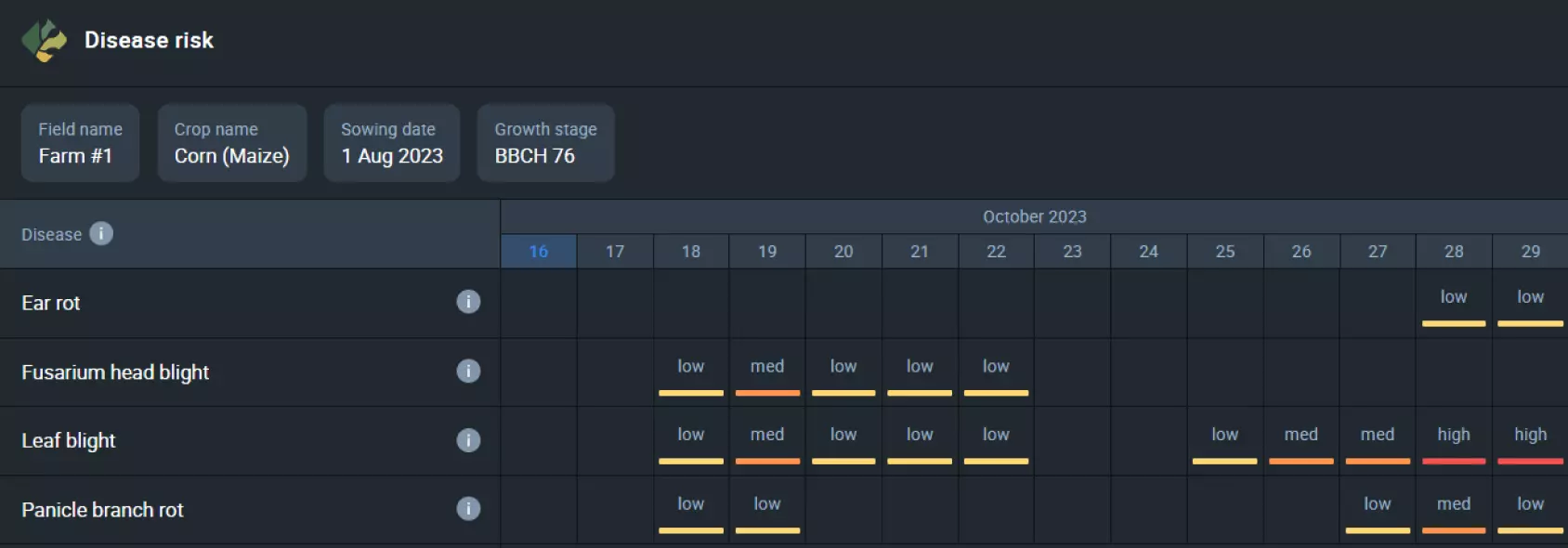
Reducing Costs Of Implementation
When you decide to invest in crop residue management strategies, you’ll need to consider the initial expenses that may arise, such as the cost of equipment. Also, it is important to allocate sufficient time to learn and adapt to low-till techniques, frequently used in tandem with CRM. Farmers may be hesitant to implement changes if they believe doing so will be too difficult or costly. Governments and NGOs (non-governmental organizations) could help farmers see the value in agricultural residue management solutions and support their implementation.
That said, precision agriculture platforms like EOSDA Crop Monitoring can provide a wealth of information for sustainable farming and crop residue management, cutting down on wasteful spending and poor management practices. Insightful vegetation indices, productivity maps, historical weather records, and a 14-day hourly forecast all contribute to farming success. By easing the transition to CRM practices and sustainable fieldwork, our technology helps large-scale farms achieve enduring, cost-effective running.
To have a conversation with our sales representative about the features that might be of interest to you, email us at sales@eosda.com.
Choose The Optimal Crop Residue Management Approach
The ultimate goal of agricultural residue management is to adopt practices that improve crop yields while reducing negative effects on the environment. The significance of crop residue management is confirmed by numerous investigations showing that the quality and quantity of the next yield can be affected by the method used to handle plant materials left after harvest .
Notably, there is no one-size-fits-all approach due to the vast range of interconnected factors relating to remnants, soil, and crops, as well as management options like soil preparation or planting dates. EOSDA Crop Monitoring can assist you in selecting the best approach by providing a greater understanding and, as a result, control over these factors. So, take your crop residue management choices carefully and periodically reevaluate them with an eye toward agricultural efficiency and sustainability.
About the author:
Vasyl Cherlinka is a Doctor of Biosciences specializing in pedology (soil science), with 30 years of experience in the field. He attended the engineering college in Ukraine and received his degree in agrochemistry, agronomy and soil science in the Chernivtsi National University. Since 2018, Dr. Cherlinka has been advising EOSDA on problems in soil science, agronomy, and agrochemistry.
Recent articles

Analyze 2025 & Plan Your Best Year Yet: LandViewer Christmas Offer
It’s the most wonderful time of the year! The Christmas holidays are here, and so is your chance to analyze 2025 and plan a prosperous 2026 with more affordable Pro plans in LandViewer.

EOSDA Models Climate Change Impact On Sugarcane Yields
EOSDA modeled future temperature, rainfall, and other climate impacts on Veracruz sugarcane. The results help growers plan long-term adaptation strategies, including timing, varieties, and irrigation.

EOSDA LandViewer Black Friday Sale: Exclusive Offers & Giveaway
This Black Friday, LandViewer offers new users the chance to save on monthly plans, get extra months with yearly subscriptions, and participate in a free annual plan giveaway.